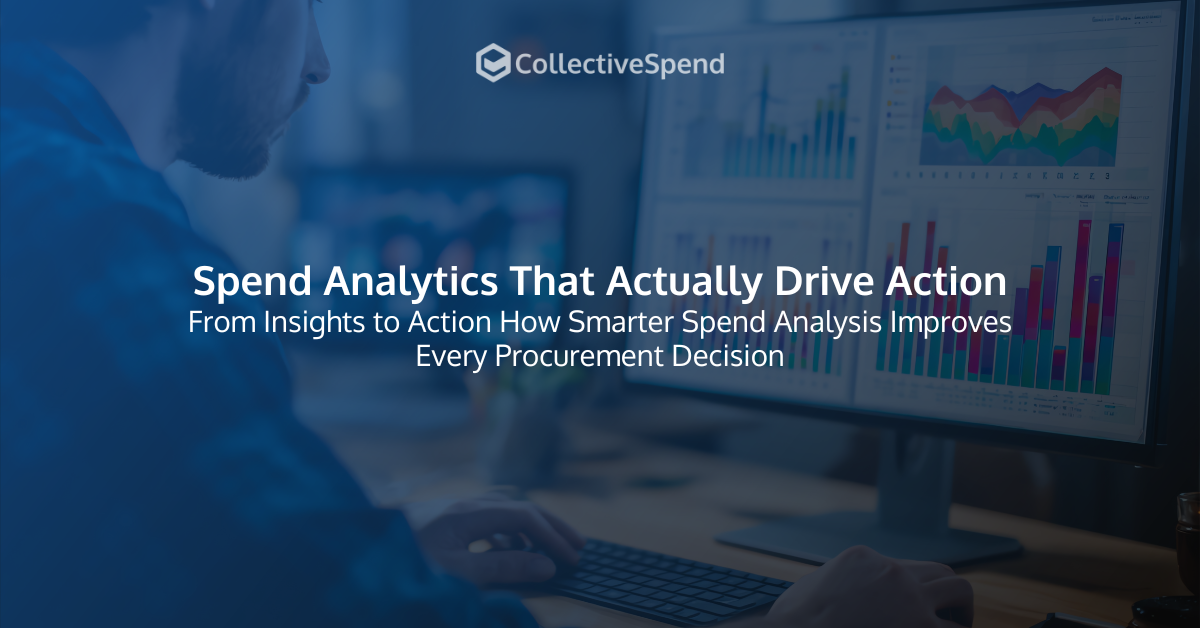Most procurement teams are sitting on a mountain of data and still struggling to know what to do with it. Reports filter in from multiple systems, dashboards light up with charts, but nothing really changes. Spend analysis solutions are supposed to unlock smarter decisions, faster sourcing cycles, and better supplier performance, but too often they fall short. The disconnect isn’t a lack of data; it’s not knowing how to turn insight into action.
Making Sense of Spend Data Isn’t the Same as Using It
Data alone doesn’t create outcomes. Plenty of companies track line items religiously but still lean on spreadsheets and email threads to make buying decisions. Just having spend data doesn’t mean it’s shaping strategy.
There’s a big difference between reporting and insight. Most reporting tools just show what happened; a reactive view of the past. By the time someone notices a spike in maverick spend or missed contract terms, the damage is done. Actionable analytics, on the other hand, point to what should change next. They help spot patterns, like repeat one-time suppliers across departments or an overreliance on low-volume purchases that quietly slip outside standard processes.
Another reason organizations struggle is that procurement systems are still fractured. Finance, sourcing, and business units often use different platforms. Without clear coverage across segments, gaps pop up fast. Fragmentation leaves entire categories, particularly indirect or spot buying, out of sight. This hurts alignment and makes strategic planning incredibly difficult.
What Action-Ready Analytics Actually Look Like
Fixing this isn’t about more dashboards. It’s about clarity. You need a system that helps teams see not just what was spent, but how it connects across functions, categories, and suppliers.
True spend analysis solutions provide an interactive view of the entire procurement map. You can see when different departments buy the same products from different suppliers or when buyers drift from contract terms. Duplicate orders are flagged before they ship, and hidden cost leaks in routine categories finally come into focus.
For meaningful impact, analytics must:
Show real-time spend visibility across business units
Flag purchases falling outside managed contracts or approved suppliers
Connect maverick spend to real business risk
These tools pack extra value when managing indirect procurement. Low-value orders, unapproved vendors, or repeat last-minute buys eat at budgets without warning. When analytics highlight these early, sourcing leaders aren’t just reporting a problem, they’re solving it.
CollectiveSpend’s spend analysis solutions bring together real-time data, supplier information, and category-level tracking within a unified platform, giving teams practical insights they can immediately act on.
Linking Spend Analytics to Operational Change
Knowing what’s happening is the first step. The challenge is embedding that insight into daily processes.
When procurement links analytics to policy, the result is more guided buying and less after-the-fact cleanup. Building workflows around recurring needs lets teams move routine orders without heavy reviews. Procurement stops policing every invoice, and users move inside new guardrails.
That same data can spark supplier consolidation efforts when teams find several groups buying the same thing from different suppliers, or when contract terms are routinely missed. These red flags become action plans for renegotiation.
Automation has a role too, especially for things like reorder triggers, catalog items, or approval paths. When these are set up off insight, manual work drops and compliance goes up, all without slowing the pace of business.
Why Indirect Spend Still Gets Ignored
Indirect spend is often ignored simply because it doesn’t raise alarms. It hides in scattered one-off purchases by teams not under central procurement. Patterns only show after comparing receipts across departments, by then the same mistake keeps repeating.
Fragmented approvals and non-contracted purchases quietly cut opportunities to save. It’s not intentional; it’s a result of lacking the right tools or visibility.
On-demand data changes the game. Now procurement can see spend behaviors as they happen, moving from gatekeeping to support. Repeated spot buys or ongoing tail vendor use come into view and can finally be addressed.
Bringing indirect transactions under platform-level analytics links every dollar of spend back to the sourcing strategy. The more you treat tail items as part of the full process, the easier it is to keep procurement in control from top to bottom.
Real Impact Starts with Thinking Smaller
Not every big win involves a global contract negotiation. Some of the biggest gains come from fixing small purchases. High-volume, low-value buys drain the budget step by step through duplicate orders, unmanaged vendors, and inconsistent pricing.
When analytics dive into day-to-day workflow, rather than just quarterly reports, results show up faster. Spending habits become opportunities to improve, not just data points for an audit. Teams soon find they are supporting better decisions, not just chasing compliance.
With CollectiveSpend’s intelligent spend analysis solutions, every layer of spend is tracked, measured, and tied to action. Better choices start to happen everywhere procurement touches. That’s what shifts procurement from a support task to a true value partner, by exposing hidden costs, enabling smarter sourcing, and making every decision count.
Ready to transform your procurement process and make every purchase strategic? CollectiveSpend is committed to providing insights that lead to smarter decisions and effective results. Discover how our tail spend management system can uncover hidden savings and enhance procurement efficiency. Partner with us and experience a seamless integration of data-driven strategies that will elevate your procurement impact.

